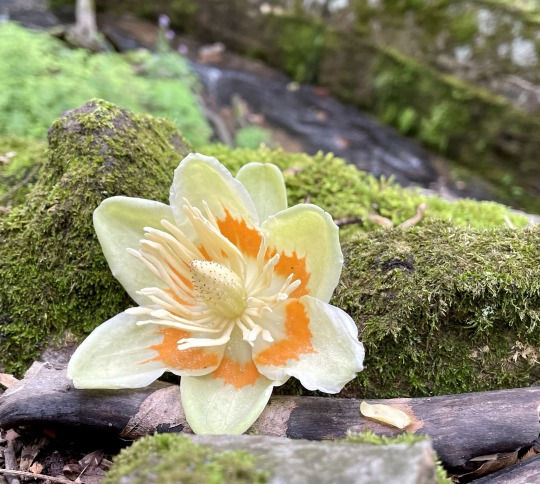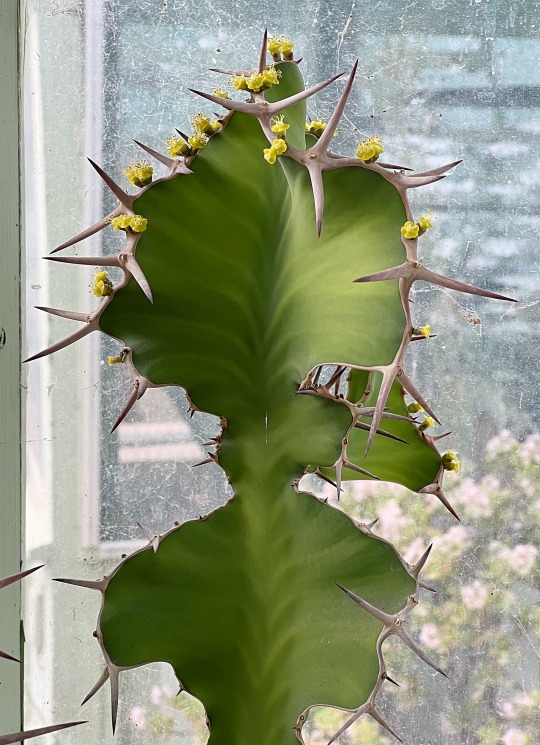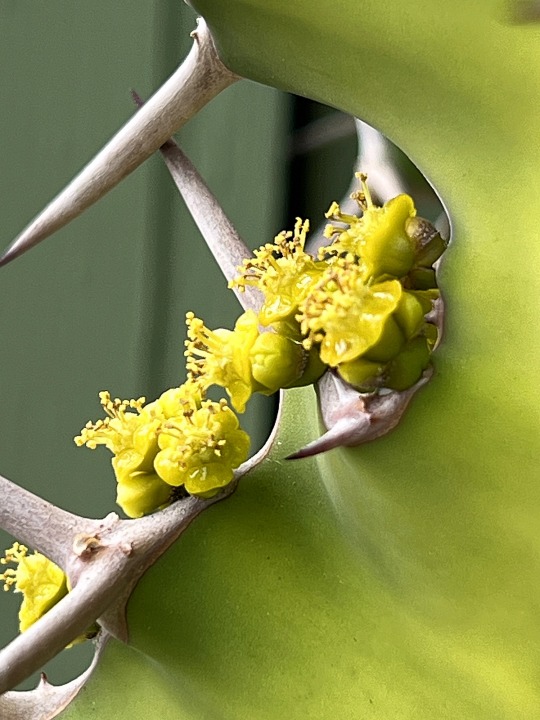Text

Cypripedium parviflorum, despite its Latin name, doesn't actually have small flowers! This species of lady's slipper orchid, often called the yellow lady's slipper, has a fairly wide range across the Appalachians and upper Midwest into the Rocky Mountains. Despite it's wide range, it's endangered in several states and sensitive to disturbance. If you see it, try not to get too close to avoid trampling the soil around its roots. This population was seen in Shenandoah National Park in Virginia.
42 notes
·
View notes
Text

Fuchsia is a common genus in gardens around the world, particularly in temperate and wet tropical areas. There are thousands of cultivars and hybrids! They're just as beautiful in the wild as they are in cultivation. Their tubular red, pink, purple, or orange flowers commonly attract hummingbirds. This combination of color and shape is part of the "hummingbird pollination syndrome", a suite a characteristics found in flowers adapted for hummingbird pollination.
This particular plant is in section Fuchsia within the genus and might be the Ecuadorian endemic Fuchsia lehmannii. Fuchsia in the wild are mostly native to the tropical Americas, with a few species found in temperate South America and a few others on islands in the Pacific.
33 notes
·
View notes
Text

Have you ever seen a weird puffball on an oak tree and thought "that doesn't look normal"? It's probably an oak gall! Most are produced by oak gall wasps (Tribe Cynipini within the gall wasp family, Cynipidae), of which there are about a thousand described and likely more undescribed species. Many oak gall wasps lay their eggs on only one or a few species of oaks.
The way galls form on plants is really interesting. The female insect lays eggs in the plant and then for some reason the plant responds by forming very unusual tissue that surrounds the egg/eggs and larva/larvae and provides them with nutrition and protection. We still don't fully understand the mechanism that promotes this growth! Many species have a multiphase life cycle where one generation has both males and females and the other has only asexually-produced females.
This particular oak gall is formed by the species Callirhytis seminator, the wool sower gall wasp. They're found on species commonly known as white oaks, like this Quercus alba. Learn more about them here!
65 notes
·
View notes
Text
This is a great photo of a tulip tree (Liriodendron tulipifera) flower. They're in the magnolia family (Magnoliaceae), and like magnolias, have an elongated receptacle with many separate ovaries, producing an aggregate fruit, as well as many spirally arranged tepals and laminar stamens. These characteristics are common in relatively early-evolving flowering plants - in scientific terms, they're plesiomorphic in the Angiosperms.

Tulip tree flower on an old stone bridge.
1K notes
·
View notes
Text
Once I was employed by a powerful corporation, and that corporation was having a standoff with another corporation, which meant that my employer was like “you know how every botanist we have is surveying a hundred acres a day, identifying plants at dinner and off the clock, doing an extra pass in meadows during their lunch breaks? Let’s put a pin in that. Here is a thousand acre watershed. Here are eight botanists. Here’s an unlimited budget for hours and equipment. Please find some stuff we can throw in the other corporation’s face.”
So we looked at the CNDDB and herbarium records — blank. We drove through the habitat. My boss steepled her fingers and said “Botrychium”. Then she bought eight pairs of waders.

Botrychium — also called moonwort— is a diminutive fern that obtains most of its nutrition from mycorrhizal fungi that are decomposing wood. It is 1-4 inches tall (2-10 cm) and it grows in meadows and streambanks surrounded by plants that are taller than 4 inches (10 cm). At the time they were identified to species by DNA extraction alone because they were CRYPTIC. But look at them! Do they have a DNA sample in spare leaves?!
Also we were eight young people who worked together 60 hours a week, ate all our meals together, shared hotel rooms, and passed around the same books and listened to the same music while in the crummy in a big broke overlapping circle. (How we got through multiple field seasons without anyone falling in love amazes me. Actually I think like six people fell in love with one guy who did not notice or care.) Our brains were all hopped up on ad hoc community and we all got. Really obsessed. With Botrychium. Here are some Botrychium beliefs we had:
- it hides
- It’s telepathic
- it can HEAR you thinking about it and will hide, so you have to think about other things the whole time.
- it unlocks locks, unties knots, and loosens fastenings that pass over it. If something gets lost or is unattached, there’s probably Botrychium nearby and we should congregate near where the thing got lost and search for this plant until the thing is found.
- in extreme circumstances, it will call animals and people to aid it and distract us from seeking it.
Normal beliefs, right? Our poor crew leader and her 6-16 staff with collective delusions
#Botrychium#Those aren't delusions those are true#Every time I think I've found a Botrychium it's a Sceptridium#but I've been walking with 80-year-olds who have the power to see it
216 notes
·
View notes
Text

Fringed spineflower, Chorizanthe fimbriata, at Cabrillo National Monument in San Diego. I absolutely love small pretty flowers like this! It has a very tiny range, growing only in southwestern California and Baja California in Mexico.
#Fringed spineflower#Chorizanthe fimbriata#plants of California#plants of Baja California#plants of Mexico
30 notes
·
View notes
Text
Washington state bans the sale of common ivy varieties starting in August
Read more at: https://www.thenewstribune.com/news/state/washington/article310485330.html#storylink=cpy Great news finally tackling this destructive invasive species!
123 notes
·
View notes
Text


You've probably seen slipper flowers like these (genus Calceolaria) on sale at a garden center near you in the warmer months. They're often very showy! Calecolaria is primarily native to the mountainous areas from Mexico to southern Argentina and Chile. Pictured are two Bolivian species that differ greatly in their flower size. The top ones are huge and showy clogs, and the bottom ones, from a lower elevation, are very dainty little slippers.
#calceolaria#slipper flowers#not to be confused with lady slipper orchids#plants of bolivia#plants of la paz
24 notes
·
View notes
Text



If you've ever been up to the highest elevations of Costa Rica, you've probably seen this plant: Chusquea subtessellata. Although it might not look like it at first from a distance, this is a species of bamboo! It's one of the dominant plants in the páramo, the alpine tundra found in the Andes and Central America.
Chusquea subtessellata is frequently mistaken for other bamboos, including the similar but South American Chusquea tessellata and the very dissimilar Andean bamboo Chusquea scandens (iNaturalist is at fault here - it tends to call any Chusquea Andean bamboo, even though they're completely different). If you're up high on Cerro de la Muerte and see something that looks like this, it's almost certainly C. subtessellata!
This species is a little strange among woody bamboos in that it flowers pretty much continuously. Most woody bamboos flower only once every few decades, with all individuals flowering at once and then dying (this is called gregarious monocarpy). Like some other very high elevation bamboos, C. subtessellata generally has a few individuals throughout the population flowering at any given time.
One thing to note about this species is that although it's not really threatened by development, it is threatened by climate change. The habitat in which this population (at Cerro de la Muerte) grew was true páramo in the 1980s, but over the last 40 years has transitioned to subpáramo. In the photos here, you can see some small trees, which are not present in true páramo. These trees are relatively recent arrivals and if they continue to spread up the mountain, they might outcompete C. subtessellata.
28 notes
·
View notes
Text

Did you know that although ubiquitous in North American and European gardens, garden nasturtiums, Tropaeolum majus, are originally native to the Andes? I found these little wild nasturtiums east of Comarapa, Bolivia, growing near cloud forest. Just like in the US and Europe, the flowers and leaves are sometimes used in salads and other foods in Bolivia.
The English common name "nasturtium" is a little misleading. The genus Nasturtium is a completely different plant: the watercress! Garden nasturtiums were named for their similarly peppery taste, but are basically completely unrelated to watercress.
116 notes
·
View notes
Text
I love when you post a species on inat and seconds later someone called "salamandergirl" "solidagoman" or "troutlilly_identifier" swoops in to ID it. Like yeah, you know what youre about. I trust your ID of my Bombus bimaculatus, "bombusboy200"
37K notes
·
View notes
Text


Euphorbia grandicornis
Euphorbia is a huge and extremely variable genus, but Africa has many spiny species that remind people of cactus plants, although they are not related. This one is Euphorbia grandicornis (meaning "big horn", in reference to its formidable spines), a shrubby species from the northeastern part of South Africa, as well as neighboring Mozambique and Eswatini. The dramatic "wings", formed by the widening and narrowing of its stems, are reminiscent of Euphorbia cooperi, but the latter becomes a large tree. Like most Euphorbia species, these two are quite poisonous, so care must be taken not to let the sap come into contact with one's eyes or other sensitive areas. The tiny yellow cyathia (the little cups containing the flowers) seem very small for such an impressive plant.
-Brian
#euphorbia#euphorbia grandicornis#Euphorbia is a VERY diverse genus both in terms of number of species and growth forms#plants of south africa#plants of mozambique#plants of eswatini#botany
261 notes
·
View notes
Text
You can keep voting if you like, but we had to come to a fast decision. The people have spoken and today we decided on "grandifolia". Thank you for your input!
Help us choose a scientific name!
We're tossing around some names for a new species with some SERIOUSLY big leaves. Botanical nomenclature requires use of Latin or Latinized Greek for descriptive plant specific epithets.
#we decided against gigantifolia even though it's fun because while large for the genus there are MUCH larger leaves in the rainforest#magnifolia was our original choice and first runner up#the genus is five syllables and sounds nice with “grandifolia”
40 notes
·
View notes
Text
Help us choose a scientific name!
We're tossing around some names for a new species with some SERIOUSLY big leaves. Botanical nomenclature requires use of Latin or Latinized Greek for descriptive plant specific epithets.
#reluctant to use maximifolia because there could still be a bigger one out there... we didn't expect to find this one#note: we might not go with the winner here#but we'd like some input!#i personally like the sound of magnifolia but it doesn't sound as BIG as some of the others#botany
40 notes
·
View notes
Text


Guadua lacerata is a newly described species of bamboo that appears to be endemic to Nayarit, Mexico. It's apparently unique among Guadua in the way that its culm leaves (the sheath-like leaves that protect growing buds on the main culm or stem) shred from the base as they age. It also has seriously weird flowers! The pseudospikelets (the usual, branching flowering structures that some bamboos have) are among the longest of any bamboos in the world and can have about twice as many flowers as any other in the genus. Pictured here are a culm leaf and a whole bunch of flowers!
Finding bamboos in flower is relatively rare. Most species do what's called gregarious monocarpy, which means that they entire population, which usually consists of hundreds to many thousands of clonal stems originating from just one or a few individual seeds, flowers at once and then dies. In bamboos, this flowering cycle can take decades, even over a hundred years, meaning we won't even live to see some populations flower! However, a few species flower regularly, even continuously. Guadua lacerata appears to be one of those regularly-flowering weirdos. This is probably a good thing, as this species also appears to be highly threatened by development.
#original article has way better photos#i just can't be bothered to do a formal attribution as the license requires#guadua lacerata#plants of nayarit#plants of mexico#bamboo
72 notes
·
View notes
Photo


Puya are drought-resistant, mainly South American terrestrial bromeliads (Bromeliaceae) that love arid sun. The Huntington has the best collection of these enigmatic plants anywhere in the country, so unless you’re trekking through the Andes in Chile, Bolivia, Peru, or Ecuador, you won’t have a chance to see rare and arresting bromeliads such as Puya alpestris and P. chilensis shoot spectacular, long-arching inflorescence blooms of blue-green, chartreuse, violet, red, and yellow three to five feet into the sky during their annual springtime bloom.
As an added bonus, Puya are well adapted to bird pollination because the flowers are full of nectar, so during the bloom, birds perch happily on the plants’ lateral floral branches that provide easy access to the nectar they love. Beware, however, as battalions of bees may be buzzing about.
“The bees obviously are also attracted by the copious nectar as are squirrels and other nectar thieves,” said Trager. “The birds actually achieve pollination, the others may not.”
Read more from “Puyas in Bloom” over on Verso
images:
Puya venusta and Puya alpestris. Photo by Deborah Miller.
242 notes
·
View notes